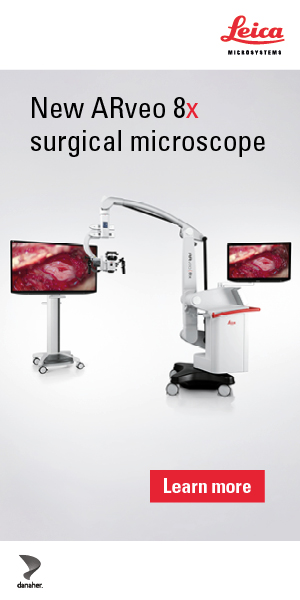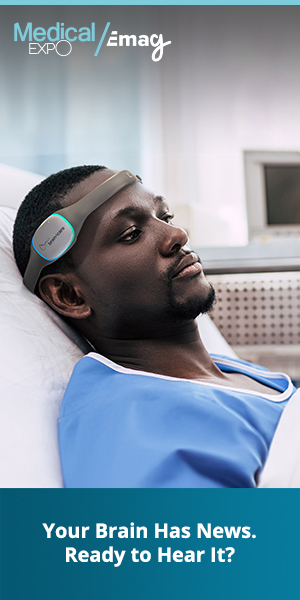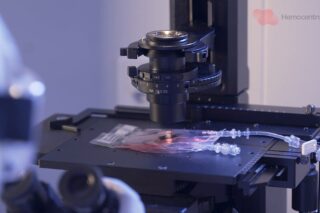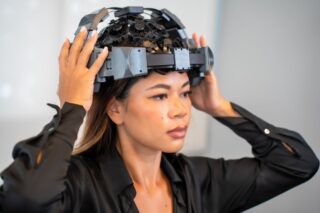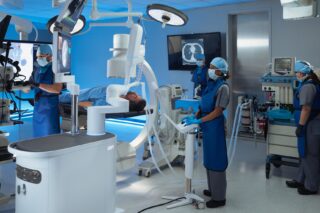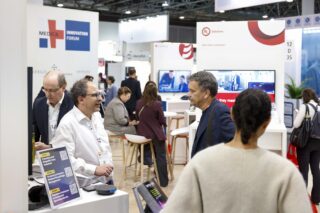LaVitre, a French company, is pioneering a new form of immersive remote medical consultations. Currently being deployed at the CHU of Aubagne near Marseille, this innovative solution has the potential to revolutionize healthcare access, especially in medical deserts.
Since COVID-19, the world has embraced remote medical consultations. Telemedicine has revolutionized healthcare, bridging the gap between doctors and patients when the pandemic restricted movement. However, today’s telemedicine tools are limited to video calls via phones or computers, showing only the participants’ faces, not their entire bodies. For medical consultations, this is far from ideal.
LaVitre (the Screen in English) seeks to go further. While video conferencing connects people, LaVitre aims to connect locations. Founded in 2019, the company offers a new, more immersive interaction between patients and doctors. The goal is to create conditions that mimic real-life interactions, allowing participants to see each other in full size as if they were physically present.
LaVitre’s solution includes a two-meter-tall, 86-inch portrait-mode screen equipped with a camera, microphone, and speaker. The entire setup is mounted on a wheeled stand for easy mobility and connects via Wi-Fi or Ethernet.
Anthony Vannier, co-founder of LaVitre explains:
“The idea is to work remotely in a more immersive way, using a full-size screen. While communication is simple and everyone can communicate remotely, we aim to bring presence into this communication. Seeing the person from head to toe significantly changes the way we communicate, making it a reciprocal experience. What happens on one screen happens on the other, enhancing both visual and non-verbal communication.”
Immersive and Inclusive Medical Consultations
According to Daniel Soultrait, Sales Manager for France and Europe, their innovative solution allows healthcare professionals to see patients in full view, enabling comprehensive cognitive and physical assessments as well as vital sign monitoring.
“Our goal is to enable healthcare professionals to perform as many consultation tasks as possible, excluding physical palpation, in a remote setting.”
This immersive approach significantly enhances the quality of remote consultations.
One of the other advantages is its inclusivity. Traditional teleconsultations via phones can be challenging for elderly or disabled patients. LaVitre’s system is designed to overcome these barriers. Anthony details:
“The goal is to have a designated space, like a room in a pharmacy, a municipal office, or another public place, equipped with a LaVitre’s screen. On the other side of the screen is the doctor.”
Damien continues:
“You don’t need a smartphone or computer. A disabled patient in a wheelchair can go to this designated room for example in a medical desert area, where a doctor is virtually waiting. For the hearing impaired, there are instant translators to facilitate communication with the doctor. Patients can have their vital signs taken without needing to handle any tools.”
Moreover, the solution will soon include sign language support, making it even more accessible for deaf and mute patients.
Combatting Medical Deserts
LaVitre is also tackling the issue of medical deserts by providing a solution that connects patients in remote areas with healthcare specialists. This setup is designed to save patients from rural areas from having to travel long distances to see specialists.
Damien elaborates,
“For a patient in a distant village who needs to consult with a diabetes expert 400 kilometers away, the patient can now stay in their village and visit a local municipal office equipped with a LaVitre’s screen to see the specialist remotely.”
Multidisciplinary Applications
The potential applications of LaVitre’s technology extend beyond individual consultations. Damien describes a scenario where multiple specialists are connected through various LaVitre’s screens in a multidisciplinary healthcare setting, such as a clinic.
“It could be a place with various specialists, like one for shoulder issues, another for leg problems, or hand conditions. The idea is to place the LaVitre’s screen where it benefits the patient the most, like in a multidisciplinary hospital service.”
This approach is already being implemented with their first healthcare client at CHU Aubagne, near Marseille in a functional rehabilitation center. The center includes geriatrics, physical therapy, and functional rehabilitation, allowing multiple types of consultations through LaVitre’s screen system. While the system was installed in February, it is expected to be fully operational by September after completing the necessary testing phases.
But Damien already highlights the benefits:
“It will allow the functional rehabilitation center to identify post-operative patients without requiring them to travel between the rehabilitation center and the hospital, which is two kilometers away.”
Always On and Intuitive Design
Unlike Teams or Zoom, which LaVitre doesn’t aim to replace, LaVitre’s solution is “always on,” explains Anthony. The idea is to create a different interaction experience compared to standard video conferencing and to replicate the feel of a traditional doctor’s office. Patients enter the room just like they would in a waiting area in a medical office. Once inside, they close the door, and the screen indicates whether the doctor is available. The doctor can see and hear the patient if they are free, or the screen remains silent if the doctor is busy or on the phone.
“The screens are always on, with privacy options available. If someone needs to connect, they just knock by tapping on the screen. When the connection isn’t active, the screen appears blurred, like frosted glass. To start a conversation, you simply knock—just like knocking on a door. We even added the sound effect to enhance the immersive experience. This mimics the natural behavior as if both parties are in the same office. The doctor can only respond if available. This ensures a realistic and respectful interaction, just like in real life where you can’t enter a locked room without permission.”
Doctors can also write messages on the screen to reassure patients, such as “I’ll be with you in a minute.”
Anthony emphasizes that the experience is designed to feel as real as possible. The goal is for the patient to be guided entirely by the doctor on the other side of the screen. For elderly patients, someone might accompany them to help set up, but no medical knowledge is required.
For doctors, training takes about 30 minutes. Once trained, doctors simply scan a QR code with their phone or computer to start using the screen.
Information Exchange
LaVitre’s technology allows doctors and patients to interact in real-time using a touch-enabled screen. The doctor can write on the screen, and it appears for the patient. Similarly, the patient can respond by writing back on the screen, making all interactions reciprocal.
It also supports sharing patient records, X-rays, and other medical documents directly on the screen. Both the doctor and the patient can interact with these documents, with the doctor able to annotate images and records during the consultation/
Anthony assures that data confidentiality is a top priority.
“No data is stored on the screen. Once the consultation is over, all information is automatically deleted from the screen.”
However, for the system to be fully effective, patient records need to be digitized. While this isn’t the case everywhere yet, Anthony remains optimistic:
“We can share the camera feed from a phone on LaVitre’s screen. Ideally, everything would be digitized, and we’re moving in that direction. Meanwhile, we have solutions.”
Future Innovations
LaVitre is continuously evolving, with plans to integrate new technologies such as vital sign monitoring through software updates. They are also exploring partnerships to enhance their offerings further.
If healthcare is their most relevant sector, there are other potential uses for LaVitre, notes Anthony:
“For example, the Ministry of Justice is interested in using LaVitre’s screen to optimize prisoner transportation and improve remote communication between inmates and judges or inmates and psychologists.
Pricing
LaVitre provides a cost-effective leasing option for its immersive telehealth solution. Clients receive the complete package for just €500 per month over 36 months: hardware, support, software, and maintenance services.
After three years, clients can opt for a subscription and receive new hardware.
For those preferring to buy the equipment outright, LaVitre offers a purchase option. The initial cost is €10,000 for the first year, followed by an annual fee of €2,500 for licensing.


